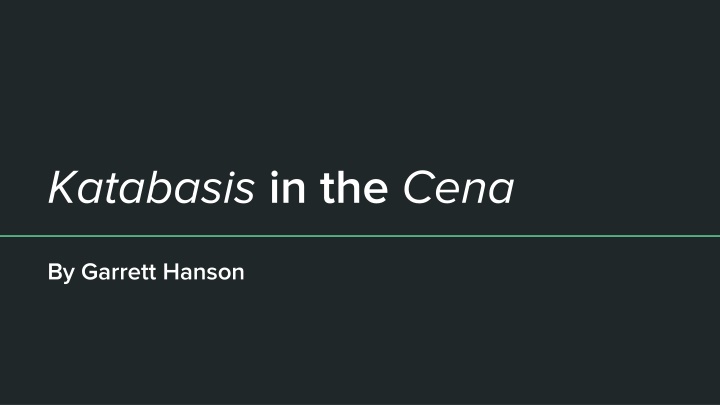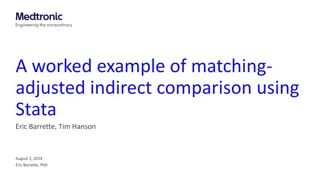
Trimalchio's Katabasis and Lavish Dining in the Satyricon
Discover the extravagant life and obsession with death of Trimalchio in the ancient Roman novel Satyricon. Explore the themes of katabasis, lavish dining, and funeral practices intertwined with intriguing characters and vivid descriptions. Immerse yourself in a journey through decadence and indulgence set against the backdrop of Roman society.
Download Presentation

Please find below an Image/Link to download the presentation.
The content on the website is provided AS IS for your information and personal use only. It may not be sold, licensed, or shared on other websites without obtaining consent from the author. If you encounter any issues during the download, it is possible that the publisher has removed the file from their server.
You are allowed to download the files provided on this website for personal or commercial use, subject to the condition that they are used lawfully. All files are the property of their respective owners.
The content on the website is provided AS IS for your information and personal use only. It may not be sold, licensed, or shared on other websites without obtaining consent from the author.
E N D
Presentation Transcript
Katabasis in the Cena By Garrett Hanson
Trimalchio: A Man Obsessed with Death horologium in triclinio et bucinatorem habet subornatum, ut subinde sciat quantum de vita perdiderit. (Sat. 26.9-10) 'eheu nos miseros, quam totus homuncio nil est! sic erimus cuncti, postquam nos auferet Orcus. ergo vivamus, dum licet esse bene. (Sat. 34.10) et, quod vobis non dixerim, etiam nunc mi restare vitae annos triginta et menses quattuor et dies duos. praeterea cito accipiam hereditatem. hoc mihi dicit fatus meus. (Sat. 77.2)
Going Down and Going In: The Beginning of the Katabasis hinc involutus coccina gausapa lecticae impositus est . . . cum ergo auferretur, ad caput eius cum minimis symphoniacus tibiis accessit et tamquam in aurem aliquid secreto diceret, toto itinere cantavit. (Sat. 28.4-5) ceterum ego dum omnia stupeo, paene resupinatus crura mea fregi. ad sinistram enim intrantibus non longe ab ostiarii cella canis ingens, catena vinctus, in pariete erat pictus superque quadrata littera scriptum 'cave canem.' (Sat. 29.1) in aditu autem ipso stabat ostiarius prasinatus, cerasino succinctus cingulo, atque in lance argentea pisum purgabat. super limen autem cavea pendebat aurea, in qua pica varia intrantes salutabat. (Sat. 28.8-9) PSITTACUS, Eois imitatrix ales ab Indis, occidit: exequias ite frequenter, aues! (Ovid, Amores 2.6). The Parrot, imitating bird from the lands of the East, has died. Go quickly to the procession, birds.
Party Till I Die: The Dinner ponticuli etiam ferruminati sustinebant glires melle ac papavere sparsos. fuerunt et tomacula ferventia supra craticulam argenteam posita, et infra [craticulam] Syriaca pruna cum granis Punici mali. (Sat. 31.10-11) "C. Pompeius Trimalchio Maecenatianus hic requiescit. huic seviratus absenti decretus est. cum posset in omnibus decuriis Romae esse, tamen noluit. pius, fortis, fidelis, ex parvo crevit; sestertium reliquit trecenties, nec umquam philosophum audivit. vale: et tu." (Sat. 71.12) potantibus ergo et accuratissime nobis lautitias mirantibus larvam argenteam attulit servus sic aptatam . . . (Sat. 34.8)
Practice Makes Perfect: Trimalchios Funeral erat autem venalicium cum titulis pictum, et ipse Trimalchio capillatus caduceum tenebat Minervaque ducente Romam intrabat. hinc quemadmodum ratiocinari didicisset deinque dispensator factus esset, omnia diligenter curiosus pictor cum inscriptione reddiderat. in deficiente vero iam porticu levatum mento in tribunal excelsum Mercurius rapiebat. praesto erat Fortuna cum cornu abundanti [copiosa] et tres Parcae aurea pensa torquentes. (Sat. 29.3- 6) 'fingite me' inquit 'mortuum esse. dicite aliquid belli.' (Sat. 78.5-6)
Textual Intercourse: Intertextuality in the Satyricon and Aeneid 'erras' inquit 'si putas te exire hac posse qua venisti. nemo umquam convivarum per eandem ianuam emissus est; alia intrant, alia exeunt.' (Sat. 72.10) . . . 'sate sanguine diuum, Tros Anchisiade, facilis descensus Auerno: noctes atque dies patet atri ianua Ditis; sed reuocare gradum superasque euadere ad auras, hoc opus, hic labor est. (Aen. 6.125-9) Child born from the gods blood, and Trojan son of Anchises, the descent into Avernus is easy: the door of gloomy Dis stands open both night and day; but to return and escape to the surface, this is work, this is toil.
Textual Intercourse: Intertextuality in the Satyricon and Aeneid . . . ut Ascyltos etiam in piscinam ceciderit. nec non ego quoque ebrius [qui etiam pictum timueram canem], dum natanti opem fero, in eundem gurgitem tractus sum. (Sat. 72.7-8) Hinc via Tartarei quae fert Acherontis ad undas. turbidus hic caeno uastaque uoragine gurges aestuat atque omnem Cocyto eructat harenam. (Aen. 6.295-7) haec placuissent, ducente per porticum Gitone ad ianuam venimus, ubi canis catenarius tanto nos tumultu excepit. (Sat. 72.7) From here is the path, which leads to the waves of Tartarean Acheron. Here seethes a whirlpool, turbid with filth and a vast chasm, and it belches out all sands into Cocytus.
Textual Intercourse: Intertextuality in the Satyricon and Aeneid Cerberus haec ingens latratu regna trifauci personat adverso recubans immanis in antro. cui vates horrere videns iam colla colubris melle soporatam et medicatis frugibus offam obicit. (Aen. 6.417-21). et Giton quidem iam dudum se ratione acutissima redemerat a cane; quicquid enim a nobis acceperat de cena, latranti sparserat, at ille avocatus cibo furorem suppresserat. (Sat. 72.9) Great Cerberus resounds through these realms with a triple-throated bay, lying massive in the cave opposite. The priestess, now seeing his necks bristle with snakes, threw down to him a narcotic cake with honey and medicated grains. (Aen. 6.417-21).
Not All Pia Coladas: Escape from The Underworld and The Labyrinth quid faciamus homines miserrimi et novi generis labyrintho inclusi, quibus lavari iam coeperat votum esse? (Sat. 73.1) contra elata mari respondet Cnosia tellus: hic crudelis amor tauri suppostaque furto Pasiphae mixtumque genus prolesque biformis Minotaurus inest, Veneris monimenta nefandae, hic labor ille domus et inextricabilis error; magnum reginae sed enim miseratus amorem Daedalus ipse dolos tecti ambagesque resoluit, caeca regens filo uestigia. (Aen. 6.23-30) Opposite, having been raised above the sea, stands the land of Crete: Here the cruel love of the bull, and Pasiphae secretly placed underneath it, and her hybrid offspring, the two- formed Minotaur, the monument of abominable Love, here that labor of the house and unsolvable maze; but Daedalus himself, having pitied the great love of the queen, solved the deceptive windings of the palace, with the thread guiding blind steps. (Aen. 6.23-30)
Not All Pia Coladas: Escape from The Underworld and The Labyrinth . . . tandem expliciti acumine Gitonis sumus. prudens enim pridie, cum luce etiam clara timeret errorem, omnes pilas columnasque notaverat creta, quae lineamenta evicerunt spississimam noctem, et notabili candore ostenderunt errantibus viam. (Sat. 79.3-5) . . . at last we were saved by the wit of Giton. Indeed, being smart the day before, since even in clear light he feared getting lost, he had marked all of the pillars and columns with chalk, which lines conquered the most thick night, and with remarkable radiance revealed the path for us wanderers.
Bibliography Arrowsmith, W. 1966. Luxury and Death in the Satyricon. Arion: A Journal of Humanities and the Classics 5: 304-31. Beck, R. 1975. Encolpius at the Cena. Phoenix 29: 271-83. Blythe, B. 2018. Apples to Apples: Forbidden Fruit in Petronius s Cena Trimalchionis. Transactions of the American Philological Association 148: 393-419. Blythe, B. 2020. Petronius Talking Birds: Mimicry and Death in the Cena Trimalchionis. Classical Philology 115: 47-69. Bodel, John. 1994. Trimalchio s Underworld In The Search for the Ancient Novel, ed. J. Tatum, 237-59. Baltimore; London: The Johns Hopkins University Press. Bodel, John. 1999. The Cena Trimalchionis. In Latin Fiction: The Latin Novel in Context, ed. H. Hofmann, 38-51. London; New York: Routledge.
Bibliography (cont.) Courtney, E. 1987. Petronius and the Underworld. The American Journal of Philology 108: 408-10. Holmes, D. 2008. Practicing Death in Petronius' Cena Trimalchionis and Plato's Phaedo. The Classical Journal 104: 43-57. Mordine, M. 2013. Odyssean Adventures in the Cena Trimalchionis. Classical Antiquity 32: 176-99. Paschalis, M. 2009. Seneca s Apocolocyntosis and Petronius Satyricon. In Readers and Writers in the Ancient Novel, ed. M. Pashcalis, S. Panayotakis and G. Schmeling, 102-14. Groningen, Barkhuis. Saylor, C. 1987. Funeral Games : the Significance of Games in the Cena Trimalchionis. Latomus 46: 593- 602. Schwazer, O. 2018. Encolpius , Trimalchio s Dog, and Vergil s Aeneid (Petr. Sat. 72.7-10). Mnemosyne 71: 1067-73.










